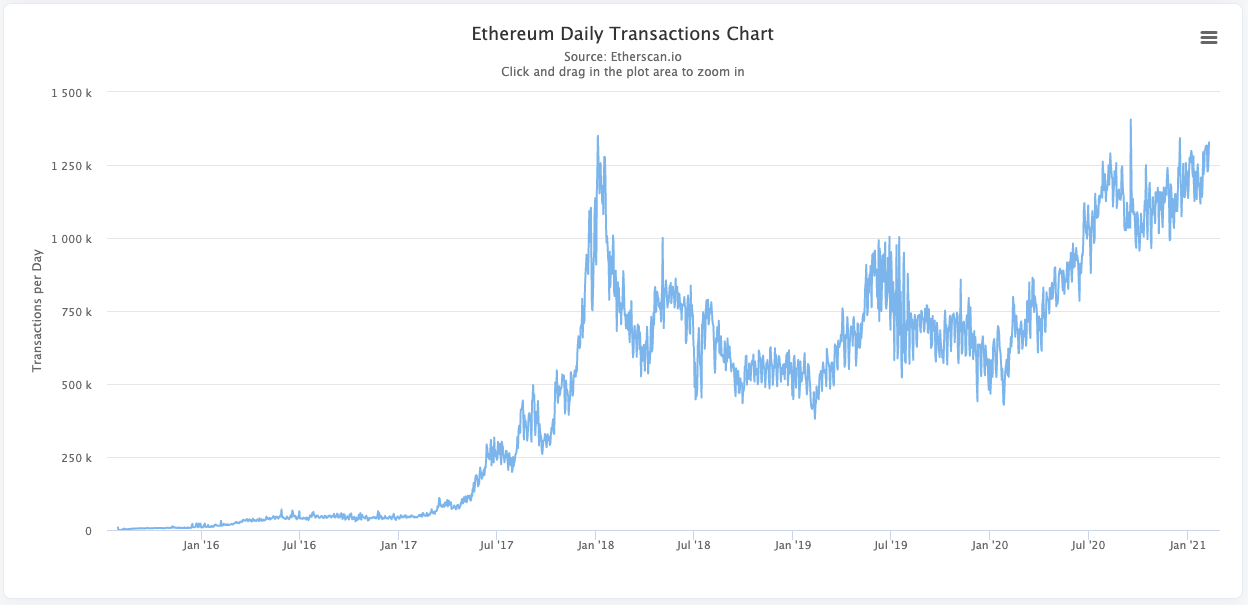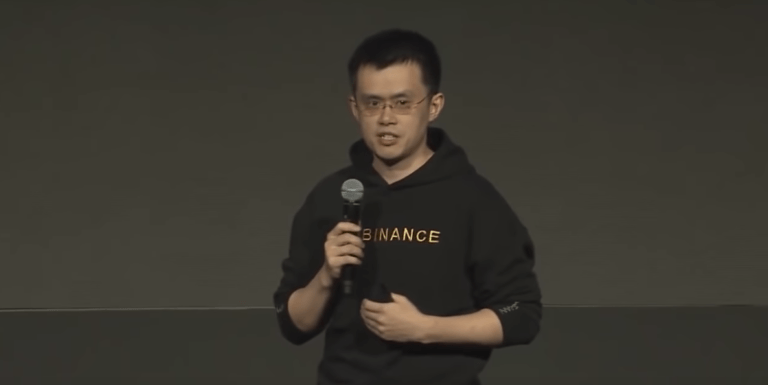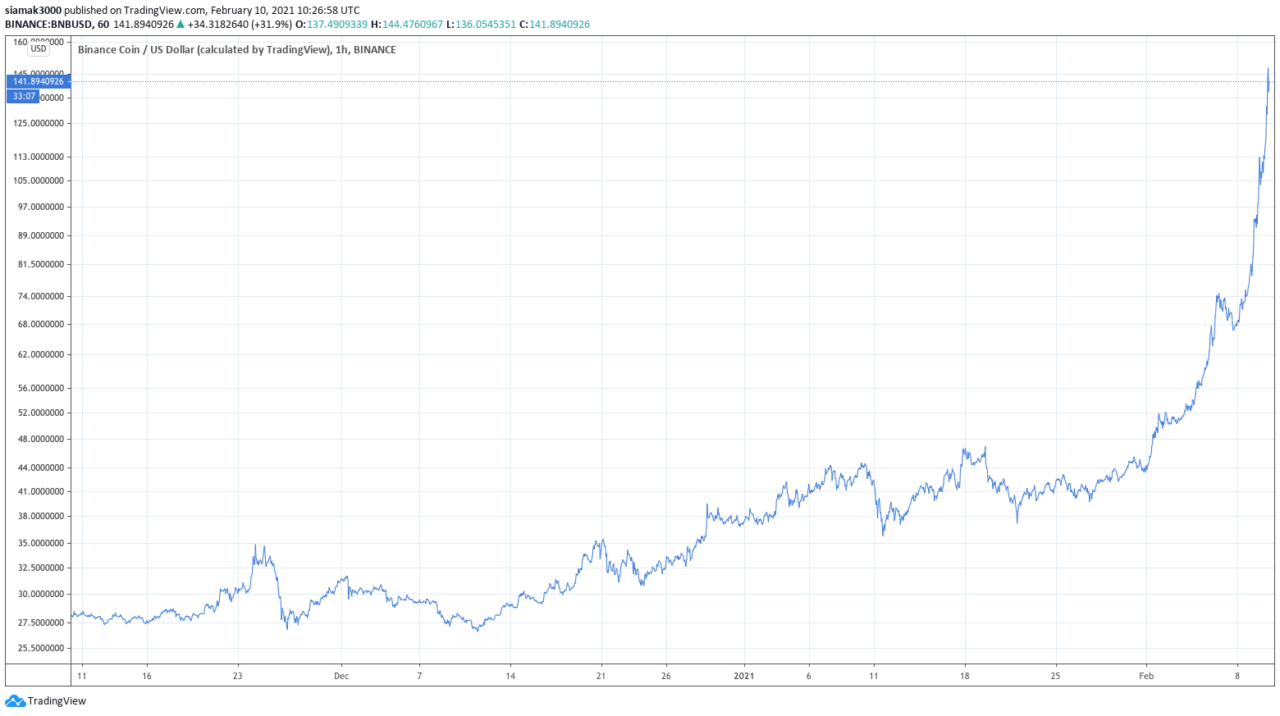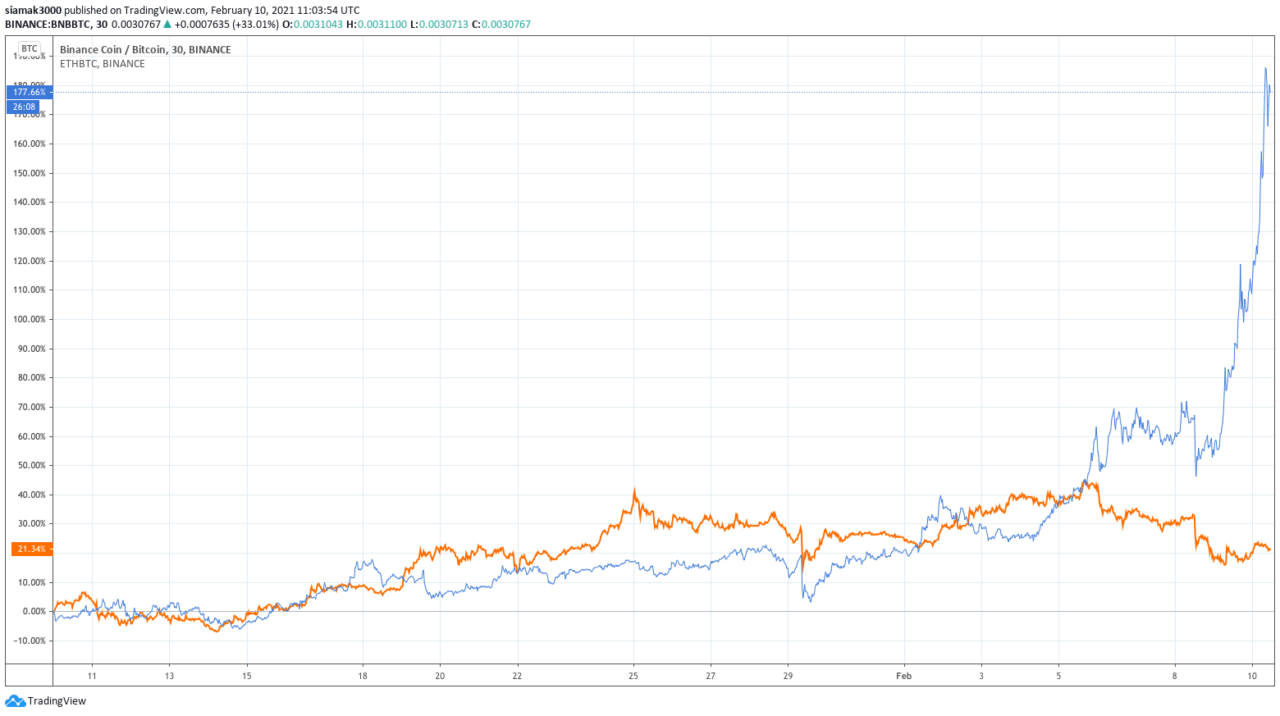On Wednesday (February 10), Binance Coin (BNB) extended the rally that has taken it from around $27.80 (on November 10) to around $145.70, where it is currently (as of 10:55 UTC on February 10), as you can see from the three-month price chart below by TradingView.
According to TradingView, at 09:03 UTC on February 10, the BNB price reached $148.03, setting a new all-time high. In the past three-month period, BNB is up roughly 424% (vs USD), and since the start of the year, BNB is up over 278% (vs USD).
In the past one-month period, both Ether and Binance Coin have generally outperformed Bitcoin, but as you can see in the chart below (BNBBTC shown in blue and ETHBTC shown in orange), starting on February 5, BNB started to outperform ETH:
So, why has BNB been performing so well in the past three months and especially in the past few days?
To understand that, it might help to have a better understanding of what BNB is and the role it plays in the Binance ecosystem.
Here is some important information about BNB from Binance Research:
“BNB powers the Binance ecosystem and is the native asset of the Binance Chain. BNB is a cryptocurrency created in June 2017, launched during an ICO in July, and initially issued as an ERC-20 token. Designed to be used for a fee reduction on the Binance exchange, its scope was extended over the years.
“BNB powers the Binance Chain as its native chain token. For instance, it is used to pay fees on the Binance DEX, issue new tokens, send/cancel orders, and transfer assets.
“BNB is also powering the Binance Smart Chain, which is an EVM-compatible network, forked from ‘go-ethereum’. It supports smart contracts and relies on a new consensus mechanism: Proof-of-Staked Authority (PoSA) consensus (‘Parlia’), which incorporates elements from both Proof of Stake and Proof of Authority. BNB is used for delegated staking on the authority validator, leading to staking rewards for users and validators.
“Besides its on-chain functions, BNB has multiple additional use-cases such as fee discounts on multiple exchanges (e.g., Binance.com), payment asset on third-party services, and participation rights & transacting currency on Binance Launchpad.
“At the core of the economics of BNB, there is a burn mechanism leading to period reductions in its total supply (~ every three months). From its initial maximum supply of 200 million, burns are expected to continue until the supply reaches 100 million.“
Binance Smart Chain (BSC) went live (on mainnet) on 1 September 2020. Some of the benefits of BSC that Binance mentioned on launch day are “cheap transaction fees that reach as low as 1 cent”, “high performance with a network capable of producing a block every 3 seconds”, and “a supportive Binance ecosystem that funds and bootstraps many DeFi projects”.
As interest in DeFi projects (most of which have traditionally run on Ethereum) has grown since last autumn, the Ether (ETH) price and Ethereum gas fees (paid in ETH) have kept going up. In this case of the latter, this has meant that Ethereum-powered decentralized app (DApps), such as decentralized exchange Uniswap, have become too expensive for many people to use.
Hence, we have over the past several months the growing popularity of other blockchains that offer higher throughput than Ethereum, e.g. Cosmos, Polkadot, Elrond, and Binance Smart Chain. Of course, none of these alternatives to Ethereum currently has many users as Binance Smart Chain.
Yesterday (February 9), Binance Co-Founder and CEO Changpeng Zhao (aka “CZ”), congratulated the team behind decentralized exchange (DEX) PancakeSwap (powered by BSC), which has managed to reach $1 billion USD in total value locked (TVL).
Later that day, CZ talked about Ethereum gas fees in the context of BSC’s usage:
And earlier today, CZ again talked about PancakeSwap (CAKE):
One crypto investor offered the following theory for the current huge popularity of BNB:
However, the main reason for today’s BNB price surge is the one offered by CZ, which is that yesterday marked the first time that Binance Smart Chain has gone past Ethereum in terms of daily number of transactions.
Below are the daily transaction charts (as of February 9) for Ethereum and Binance Smart Chain:


The views and opinions expressed by the author are for informational purposes only and do not constitute financial, investment, or other advice.











